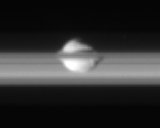Pan (moon)
Pan is a moon of Saturn. It is the closest moon to the planet, orbiting 133,600 km above Saturn's cloud tops. It was discovered in 1990 by Mark Showalter. He discovered Pan when he was analysing the photos taken by Voyager 2.[3] It orbits inside the Encke gap which it has made Saturn's A Ring.
 Pan amid the rings of Saturn. The 'side' view gives Pan the appearance of being embedded in the rings, although it actually travels within the Encke Gap. | |
| Discovery | |
|---|---|
| Discovered by | M. R. Showalter |
| Discovery date | July 16, 1990 |
| Designations | |
| Adjectives | Pandean |
| Orbital characteristics[1] | |
| 133,584.0±0.1 km | |
| Eccentricity | 0.0000144±0.0000054 |
| 0.575050718 days (13.801217 hours) | |
| Inclination | 0.0001°±0.0004° |
| Satellite of | Saturn |
| Physical characteristics | |
| Dimensions | 34.4 × 31.4 × 20.8 km |
Mean radius | 14.1 ± 1.3 km[2] |
| Mass | 4.95 ± 0.75 ×1015 kg[2] |
Mean density | 0.42 ± 0.15 g/cm³[2] |
| 0.0001–0.0018 m/s2 | |
| ~0.006 km/s | |
| synchronous | |
| zero | |
| Albedo | 0.5 |
| Temperature | ~78 K |
Pan was named after the Greek god Pan on 16 September 1991.[4] It is also known as Saturn XVIII.[5]
Its mass is in the range [math]\displaystyle{ 4.95 \pm 0.75 \times 10^{15} kg }[/math].[6]
Pan (moon) Media
Pan, photographed by Cassini on March 7, 2017. The thin equatorial ridge is clearly visible.
References
- ↑ Jacobson, R. A.; et al. (2008). "Revised orbits of Saturn's small inner satellites". Astronomical Journal. 135 (1): 261–263. Bibcode:2008AJ....135..261J. doi:10.1088/0004-6256/135/1/261. S2CID 122998668.
- ↑ 2.0 2.1 2.2 Thomas, P. C. (July 2010). "Sizes, shapes, and derived properties of the saturnian satellites after the Cassini nominal mission" (PDF). Icarus. 208 (1): 395–401. Bibcode:2010Icar..208..395T. doi:10.1016/j.icarus.2010.01.025. Archived from the original (PDF) on 2018-12-23. Retrieved 2011-10-28.
- ↑ IAUC 5052: Saturn 1990 July 16 (discovery)
- ↑ IAUC 5347: Satellites of Saturn and Neptune 1991 September 16 (naming the moon)
- ↑ "Planet and Satellite Names and Discoverers". Gazetteer of Planetary Nomenclature. USGS Astrogeology. July 21, 2006. Retrieved 2007-09-14.
- ↑ "Sizes, shapes, and derived properties of the saturnian satellites after the Cassini nominal mission" (PDF). Archived from the original (PDF) on 2018-12-23. Retrieved 2011-10-28.




